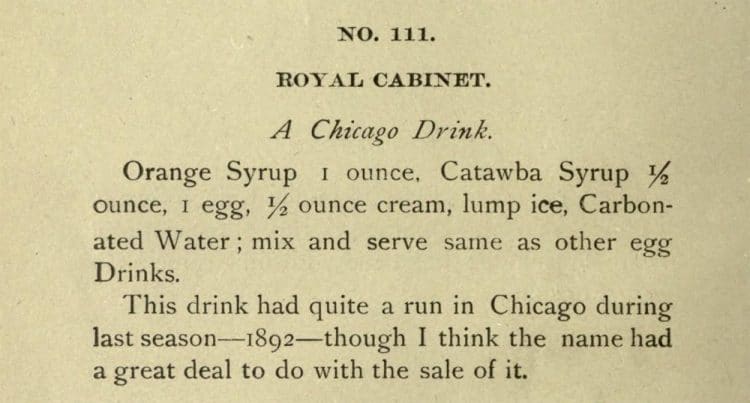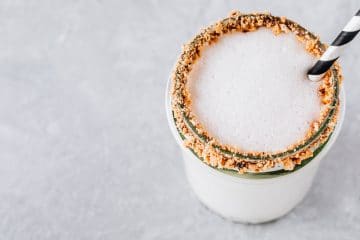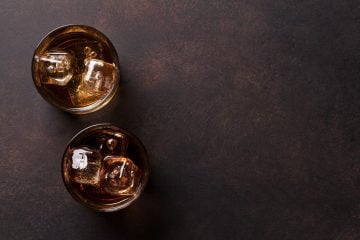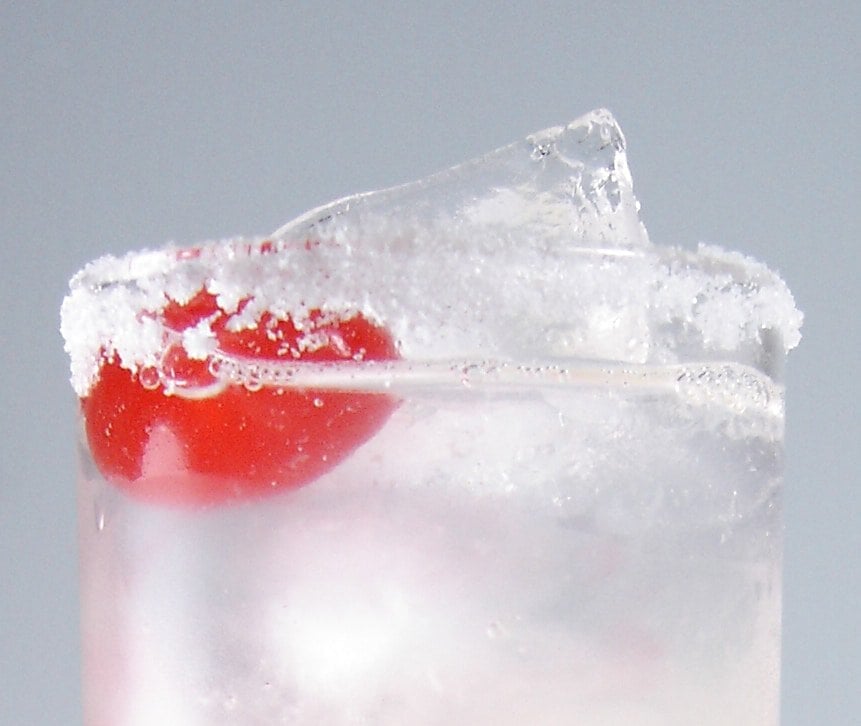Rhode Island seems to be a sleepy little state nestled amongst giants like New York and Massachusetts. One of the state’s quirks is the drink called the cabinet which to the rest of North America is called a milkshake or ice cream shake. The Coffee Cabinet (or coffee milk) is the states official drink. Why do they call them cabinets and where does the name originate? Surprisingly, nobody knew, until now.
There have been a few creative thoughts on this question. The most popular one is you need a blender to make a milkshake, and a “cabinet is where the blender was kept.” Another group suggests it comes from an old brand of whisky and sparkling wine called Royal Cabinet with the name suggesting “ it was suitable for a monarch’s private chambers.” Someone thought this linguistic progression—if narrated by Matt Damon in Good Will Hunting—was the solution: carbonated—cahbinated—cahbinate—cabinet. These theories exhibit some scatological thinking. Where the name comes from is a popular soda fountain drink called the Royal Cabinet from Chicago in 1892.
The first occurrence of a Cabinet comes from The National Druggist, Volume 21 (1892) describing Chicago’s unique soda fountain environment and their signs advertising “Royal Cabinets.” The first recipe comes from Deforrest Saxe in “Saxe’s Guide Or, Hints to Soda Water Dispensers (1894)”, on page 72, recipe No. 111. In the description of the recipe, he states:
“This drink had quite a run in Chicago last season—1892—though I think the name had a great deal to do with the sale of it.”
Royal Cabinet
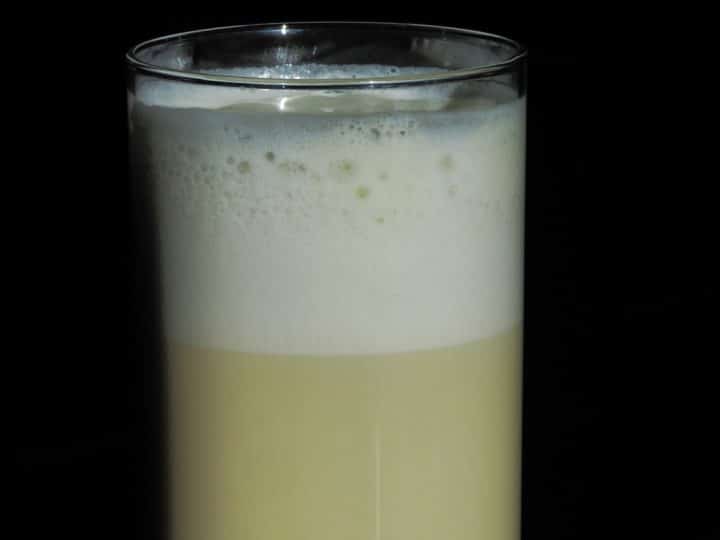
A Chicago Drink
Ingredients
- 1 oz Orange Syrup
- ½ oz Catawba Syrup
- One egg
- ½ oz cream
- Carbonated water
Instructions
- In a Boston shaker combine the syrups, egg and cream with 2 cubes of ice
- Shake vigorously until thoroughly combined
- Strain into a tall 8 to 10 ounce glass,
- Fill the remaining space in the glass with carbonated water
Notes
Catawba syrup is merely equal parts of Catawba wine and simple syrup. If you can't find Catawba, I'd recommend a ½ oz of sweet concord grape wine which would be nearly equivalent to the Catawba syrup.
Orange syrup is 1½ oz of orange extract, ½ oz fruit acid (citric) and 1-gallon simple syrup. The recipe for the simple syrup here is 6 lbs of sugar to a gallon of water, cold processed. This is a much thinner and less sweet syrup that is typically used for cocktails.
Using a whole egg makes the drink a pale, dull, yellow colour. However, what it lacks in looks it makes up for in flavour and texture. Smooth and silky with a creamsicle flavour, it is a robust drink.
What makes this recipe similar to a milkshake is that egg creams were shaken vigorously to make a light, frothy beverage. The original milkshake was simply made with whole milk, flavour syrup, some ice and no egg, and shaken until it was light and frothy. Rhode Islanders still follow the historical milkshake recipe.
The Cabinet’s popularity is enough that after Deforrest Saxe’s book, the recipe appears in The Pharmaceutical Era (1896), a weekly publication for druggist and soda fountain operators, as being popular in Detroit. Then in 1899 it is published in the Standard Manual of Soda in the egg drinks section—a few page flips away from the original Egg Cream. And it continued to be listed as a drink in The Dispenser Soda Water Guide in 1909.
The menu at Hartman’s Hotel (1901) in New York shows the Royal Cabinet as a mixed drink along with Egg Nogg, Milk Punch, Milk Toddy and Brandy Milk Punch, all dairy-based beverages. To confuse matters, under the Rye Whiskey menu heading, a Royal Cabinet whisky brand is listed.
Coffee Cabinet
The Cabinet popular in Rhode Island is the coffee version and the first occurrence of the Coffee Cabinet comes from the Spatula in 1903:
“A drink that has become the most popular is “Coffee Cabinet,” consisting of coffee syrup, egg, plain cream, ice cream, and shaved ice, thoroughly shaken. The coarse stream of soda is drawn and the drink is strained. This has often been called a meal in itself.”
The Coffee Cabinet recipe also appeared in the Pharmaceutical Era in 1919.
If you compare the two drinks, you can see the Coffee Cabinet has a direct lineage to the Royal Cabinet, and the Spatula published a recipe for the original drink in 1901, so there is a direct connection between the two drinks.
A “New Royal Cabinet” is detailed in the Practical Druggist and Pharmaceutical Review of Reviews, Volume 40 in 1922.
New Royal Cabinet
Into a mixing glass draw equal parts of pineapple and orange syrups. Into this break an egg and add one ounce of white grape juice and mix with the electric mixer and then fill with carbonated water. Some add sweet cream to this and make it a truly rich beverage.
There are other mentions in books and newspaper articles, and like many soda fountain drinks, the formula changes over time and are simplified. Fresh eggs were removed from most soda fountain drinks because they caused a great deal of illness and cream was removed because it was expensive, taxes were being applied to soda drinks, and imbibers of these kickshaws were price sensitive. Milk made a reasonable and inexpensive substitute.
We could end it there with the origin mostly solved, but Saxe’s comment about how “the name had a great deal to do with the sale of it” aroused my curiosity.
Why was it called a Royal Cabinet and what is a Royal Cabinet?
Mr. Saxe’s comment about the Royal Cabinet seemed to be tongue-in-cheek. People don’t make out of place statements about regular occurrences; however, something that is funny or odd can often elicit a statement. In the case of the Royal Cabinet, I believe that is what Saxe was alluding too.
Many cocktails have tongue in cheek names and so do soda fountain drinks. They even have their own language, documented in a 1935 research paper titled: “Linguistic Concoctions of a Soda Jerker.” Many of the documented phrases plumb a rich vein of humour. It is a fact that soda-men have a long history of being jerks.
Whenever you do research the obvious first starting point is to do an Internet search. This resulted in some possible name origins. The obvious one being storage cabinets, but the term was also used to refer to a collection of rarities or a “curiosity cabinet” as well as a group of advisers to the throne. There is also the previously mentioned wine and whisky brands with the name Royal Cabinet.
Taking the name from a recognized brand and applying it to a drink is unlikely, and would cause confusion. Naming the drink for a group of royal advisers is unlikely, but it would be more relevant if the drink contained alcohol. Many important decisions have been made while consulting a glass of whisky, but alas there is no alcohol in a Royal Cabinet.
The term cabinet sounds rather benign, but the word has many meanings and one that comes to mind is as a reference to a toilet. In Italian, a term for the toilet is “il gabinetto” (the cabinet), and a polite method of finding a toilet in France is to ask for “les cabinets.” Historically a Royal Cabinet is a reference to the cabinet in the toilet facilities that housed a wash basin and the chamber pot, some people call them a vanity today. The term comes from royal commode—commode being old French for a cabinet that housed a chamber pot—which over time has been shortened to just commode, which is now a reference to either a toilet in parts of the US or a portable toilet chair. The “royal” part comes from the fact that toilets were first invented for royalty. These modern toilets eventually trickled down to the common people.
There are still companies that manufacture Royale Commode chairs. And some modern manufacturers still brand washroom cabinets as a Royal Cabinet.
There is considerable semantic drift for the term, but it isn’t much of a stretch to infer that the Royal Cabinet drink name might be a euphemism for a toilet.
Bob Cromwell, an amateur toilet sleuth at Toilet Guru states: “I could imagine its use as an intentionally facetious way to refer to a bathroom or a toilet as if it were grandiose.”
Would a soda fountain ever use such a distasteful name for a drink? Of course they would! There is a long history of both soda jerks and bartenders using creative and funny names for drinks.
The pharmacy where the first appearance of the Royal Cabinet drink is first mentioned is also critiqued by a Canadian pharmacist and was published in 1892, in a critical Yelp-like review. The article involves “spleen venting,” and if you read the complete article, you will also see that blaming Canada was alive and well in the 1890s. As Englishmen See Us (click to read)
The mentioning of the Royal Cabinet amid more common drinks, in the journal write-up, probably piqued the interest in the drink amongst many other soda fountains, helping it gain popularity. The recipe is effectively just an orange flavoured egg cream, almost like a Creamsicle. This pharmacy sounds like a place that would have fun with the names of its drinks based on the commentary. And this may support Saxe’s contention that the drink’s popularity was based on the unusual name, not the flavour.
If you look at Deforrest Saxe’s recipe for the Royal Cabinet, you will see the recipe just above it is called a Flowing Stream. I may be reading too much into this, but is this a coincidence or purposeful piece of humour?
I could continue to circle the bowl on toilet history, but there are better people than me to tackle this subject. If you want to know more, these links will give you a good summary on lavatory language and the history of the toilet.
As for linguistic theories, the Royal Cabinet and Coffee Cabinet existed before the blender, so it was not named for where the blender was stored. Was it named for a toilet? Quite possible.
And with that, I suspect I am now persona non grata in Rhode Island. Sorry.

